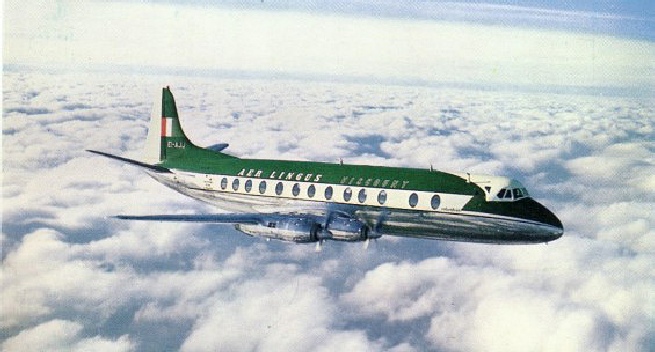From “The Independent”.
An investigation into Ireland's worst civilian aircraft crash is expected next month to clear the British military of any involvement.
The tragedy of Aer Lingus flight 712 in which 61 people died has haunted the authorities on both sides of the Irish sea for more than three decades. Since the Vickers Viscount 803 airliner, named the St Phelim, disappeared into the Irish Sea in 1968 there have been allegations that it was accidentally hit by a missile launched from an RAF missile base at Aberporth, near Cardigan, Dyfed, on the west coast of Wales.
Over the last 30 years the mystery has become the Irish equivalent of the Lockerbie tragedy fuelled by speculation and claims of conspiracies and cover-ups. Last year, the Irish government launched a fresh inquiry to discover the truth and next month it is expected to reveal it has found nothing that incriminates Britain's Ministry of Defence.
The report, largely based upon previously secret documents relating to the missile range that were supplied by the Ministry of Defence in London, is now expected to say that the Irish government officially accepts that the British military was not to blame.
Flight 712 left Cork for London Heathrow at 11.32am on 24 March 1968. Captained by Barney O'Beirne, a very experienced 35-year-old former Irish Air Force pilot, the St Phelim was carrying 57 passengers and four crew.
Most of the passengers were from Co Cork. There was also a delegation from the Irish Ministry of Agriculture going to an international conference, some Americans, Belgians and a group of Swiss tourists who were returning home after a fishing holiday.
Nearly half an hour into the flight, the Viscount was nine miles off Hook Head on the south coast of Ireland. The crew acknowledged a message from Shannon air-traffic control to change to the London Airways frequency.
Half a minute later, just before midday, the crew of another scheduled Aer Lingus flight heard 712's co-pilot give its call sign "Echo India Alpha Oscar Mike, with you". A few seconds after that came flight 712's last recorded words: "12,000 feet, descending, spinning rapidly".
The mystery remains as to why the aircraft, on "a fine sunny Sunday", flying on a straight and level course at 17,000ft, spiralled into the Irish Sea killing all on board. Forty seven bodies have never been recovered.
Eyewitnesses on the shore told the Irish Air Investigation Authority that they had seen explosions and objects in the sky that day. The authority tried to find the cause of the crash but its inconclusive verdict was to act as grist to the conspiracy theorist's mill for three decades.
Richard O'Sullivan, who was the Republic of Ireland's inspector of transport at the time, wrote: "The conclusion that there was another aircraft involved is inescapable... No aircraft have been reported missing but there remains the possibility that an unmanned aircraft, either a drone target aircraft or a missile, might have been there."
After a 30th anniversary memorial service was held in Cork last March, the families of the victims decided to form a committee to press for the truth. Captain O'Bierne's son Davy said: "As a group we thought we could bring more pressure banging on doors than we could as individuals."
After 30 years of blaming the British government, campaigners have been somewhat disarmed by its openness this time round. Last year, Dame Veronica Sutherland, then British ambassador to Dublin, made strenuous effort to obtain files and information for the families of the victims. She also met with Mary O'Rourke, the Irish Public Enterprise Minister who is in charge of inquiries into flight 712. All MoD documents were later handed over to the Irish investigators.
A senior Royal Air Force officer who was based at Aberporth in the late Sixties flatly rejected any claims that the base there was involved in the loss of the aircraft. He said: "The officer in charge at the time was a close personal friend.
“The range WAS closed on Sundays”.
He also said, "I get angry at these allegations, as though there was any possibility of covering up such a thing. You could not possibly keep it quiet among the hundreds of people who worked there. What I do know is that this has been good propaganda for the IRA, as it roused anti-British feeling."
The new investigation has also been closely examining the possibility of a fault in the aircraft that disappeared.
Of 50 Viscounts built, one in 10 were involved in fatal accidents.
On March 24th 1968 Aer Lingus flight 712 came down near Tasker Rock in the Irish Sea. Both RAE and RAF Aberporth immediately became chief suspects, despite proof from the MOD that Aberporth was non operational that day.
However unfortunately for the protesters, it happened on a SUNDAY, and the RAE as usual was CLOSED and non operational over the complete week-end.
To run trials at week-ends would have entailed calling in many staff not just at Aberporth, but to RAE Llanbedre as well. Very expensive. Do the protesters think you can keep up to a hundred people from talking were it true, even with the Official Secrets Act ?
From the BloodHound Firing Unit point of view, it was in the third year of my first tour at Aberporth and I remember seeing it on TV the night the plane went down, and know for a fact that the range was not working.
Because of the rumour being reported by the BBC, it was the main topic at work the following day. (Monday).
The rumour started snowballing, and kept on going for over thirty years.
See “The Independent” article below.










